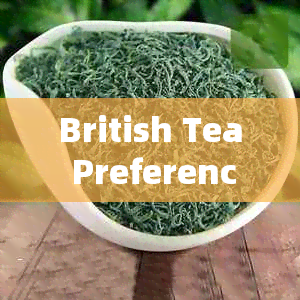British Tea Preferences: Milk and Sugar vs. Chinese Tea Culture
British Tea Preferences: Milk and Sugar vs. Chinese Tea Culture

Introduction
Tea, as a popular beverage, holds a significant place in the cultural heritage of both Britn and China. Despite the shared reciation for this aromatic drink, the way it is consumed varies greatly between these two nations. While British tea culture often involves adding milk and sugar to their brew, Chinese tea traditions emphasize the purity and simplicity of the tea itself. This article delves into the historical and cultural factors that have shaped these distinct preferences and explores the nuances of British tea with milk and sugar versus Chinese tea culture.
The British Love for Milk and Sugar in Tea
Historical Context
The British tea tradition dates back to the 17th century when tea was introduced to the country by the British East India Company. Initially, tea was an expensive luxury enjoyed only by the elite. However, as trade expanded and tea became more accessible, it gradually became a staple in British households.
The practice of adding milk and sugar to tea can be traced back to the 18th century. During this time, milk was a common addition to many beverages, including tea, as it was believed to d digestion and provide additional nutrients. Sugar, on the other hand, was a symbol of wealth and status, and its addition to tea was a way to showcase one's affluence.
Culinary Influence
The British preference for milk and sugar in tea is also influenced by their culinary traditions. British cuisine often features a combination of sweet and savory flavors, and the addition of milk and sugar to tea aligns with this flavor profile. Additionally, the British love for afternoon tea, complete with a selection of cakes and pastries, complements the sweetened tea, creating a harmonious pring.
The Ritual of Making British Tea
The process of making British tea is a ritual that many take seriously. Typically, tea leaves or tea bags are placed in a pot and boiling water is poured over them. The tea is left to steep for a few minutes before milk and sugar are added according to personal preference. The result is a rich, warm, and comforting beverage that is a staple in British dly life.
Chinese Tea Culture: Simplicity and Elegance
Historical Roots
Chinese tea culture, on the other hand, has a much longer history, dating back over 5,000 years. Tea was first used for medicinal purposes in China before it evolved into a cultural phenomenon. The Chinese have always valued the natural flavors and health benefits of tea, and their roach to tea drinking is characterized by simplicity and elegance.
The Art of Tea Preparation
In Chinese tea culture, the preparation and consumption of tea is an art form. Tea is typically brewed using fresh leaves and clean water. The water is heated to a specific temperature depending on the type of tea being prepared. The tea leaves are steeped briefly and then discarded, with the second and subsequent infusions being used for consumption. This method ensures that the tea retns its natural flavors and aroma.
The Significance of Tea in Chinese Society
Tea plays a significant role in Chinese social and cultural life. It is a symbol of hospitality and is often served during gatherings and ceremonies. The Chinese tea ceremony, known as Gongfu Cha, is a meticulous and intricate process that emphasizes the beauty and harmony of tea. It is a meditative experience that involves precise movements and a deep reciation for the tea's flavor and aroma.
Comparative Analysis: Milk and Sugar vs. Chinese Tea Culture
Flavor Profiles
The flavor profiles of British tea with milk and sugar and Chinese tea are distinctly different. British tea is often described as rich, creamy, and slightly sweet, while Chinese tea is known for its delicate and nuanced flavors. The addition of milk and sugar in British tea serves to mask the natural bitterness of the tea leaves, while Chinese tea drinkers reciate the subtle notes and complexities of the tea itself.
Cultural Significance
Both British and Chinese tea cultures hold deep cultural significance. In Britn, tea is a unifying element that brings people together, whether for a casual cuppa or a formal afternoon tea. In China, tea is a symbol of respect, harmony, and tranquility. It is a part of dly life and is also used in religious and spiritual practices.
Health Perspectives
From a health perspective, the addition of milk and sugar to tea can alter its nutritional benefits. While tea itself is rich in antioxidants and has numerous health benefits, the added milk and sugar can increase the calorie content and potentially reduce the absorption of certn nutrients. Chinese tea, on the other hand, is consumed in its pure form, maximizing its health benefits.
Conclusion
In conclusion, the preferences for tea consumption in Britn and China are deeply rooted in their respective histories, cultures, and culinary traditions. British tea with milk and sugar offers a comforting and flavorful experience, while Chinese tea culture emphasizes the natural beauty and health benefits of tea. Both roaches to tea drinking have their unique eal and continue to be cherished by their respective societies
责任编辑:蔚不束
特别声明:本文为taizhou资讯创作者或机构上传并发布,仅代表作者观点。taizhou资讯仅提供信息发布平台。